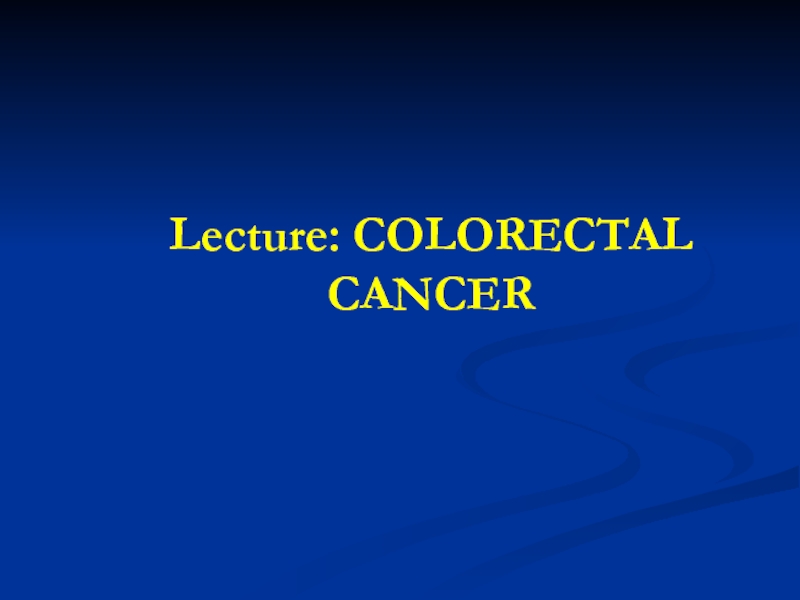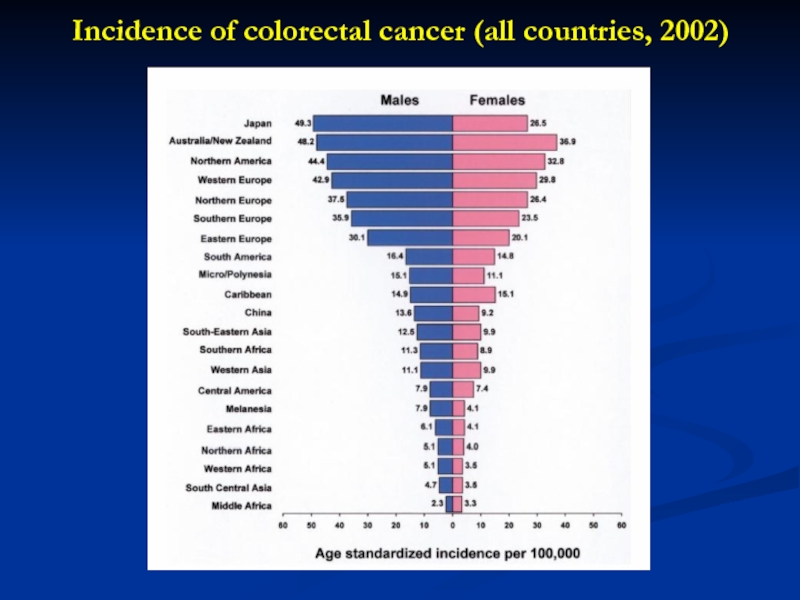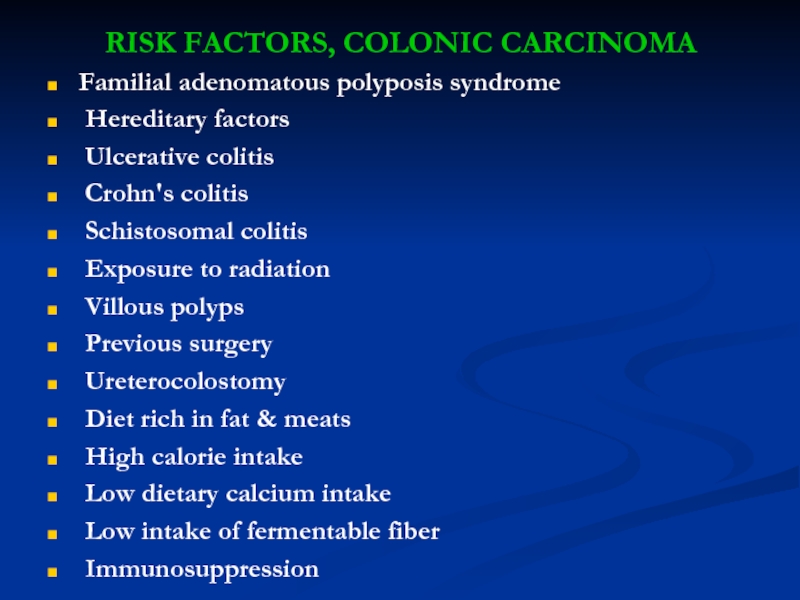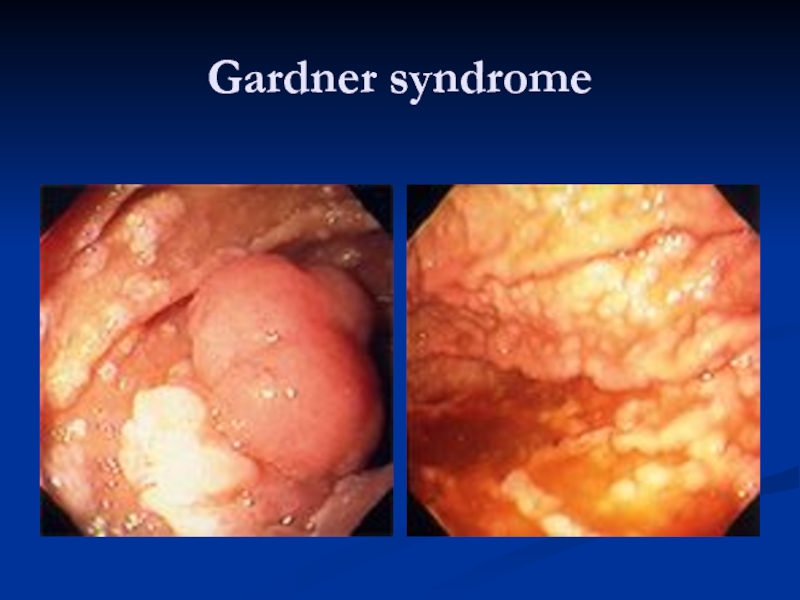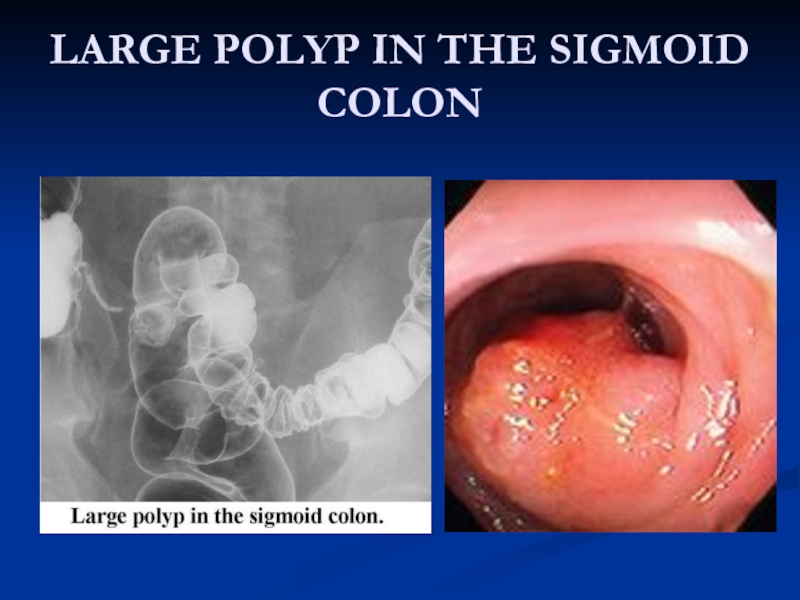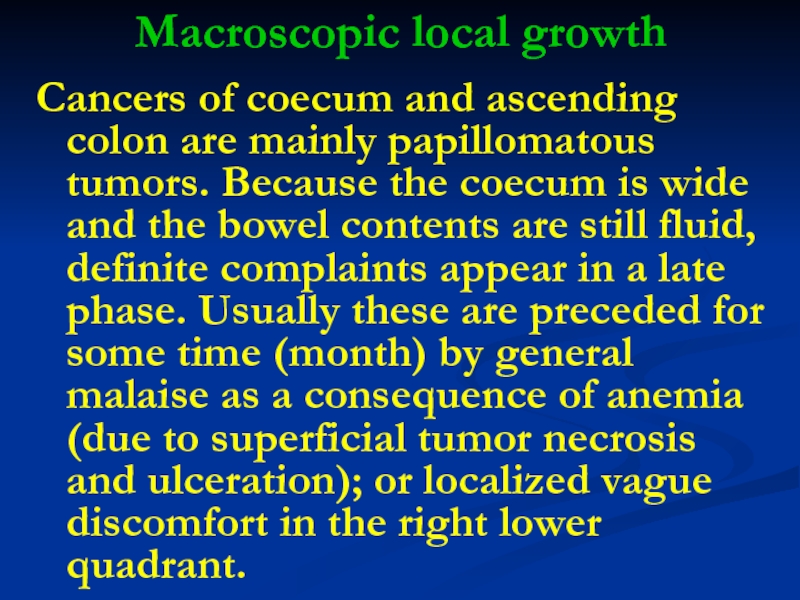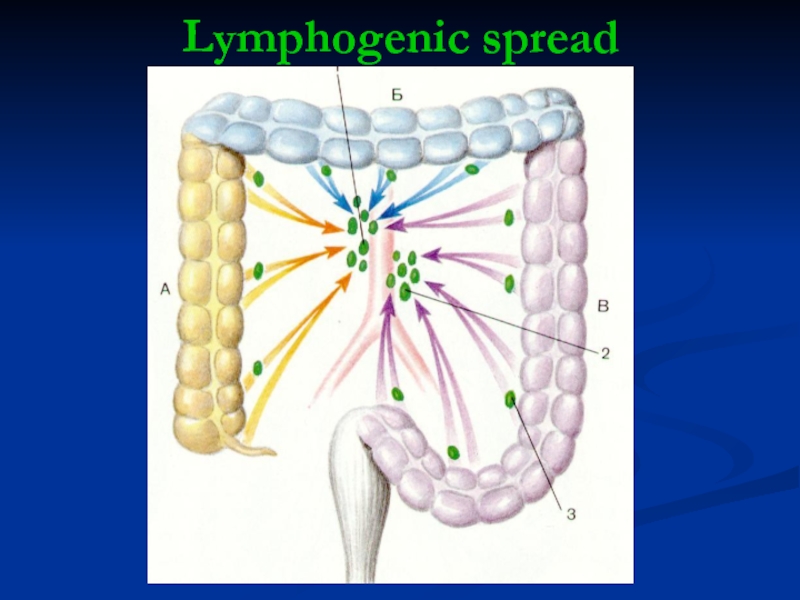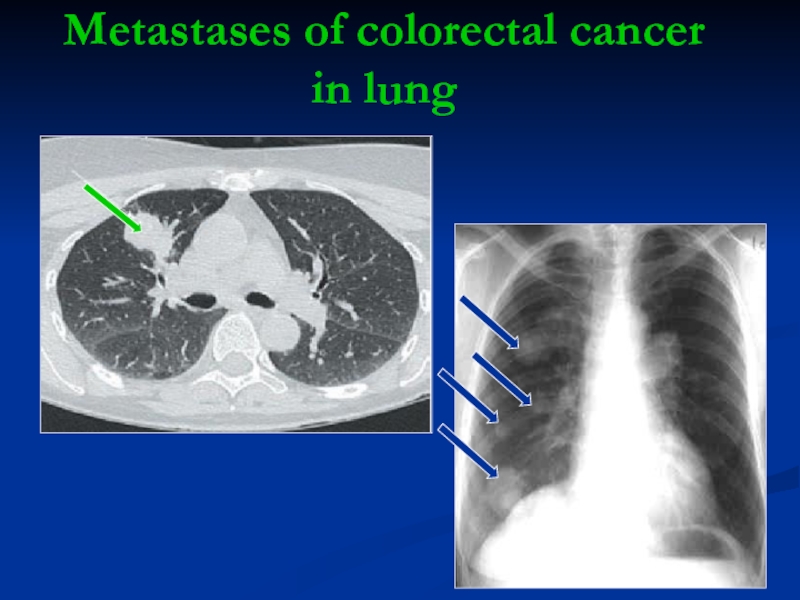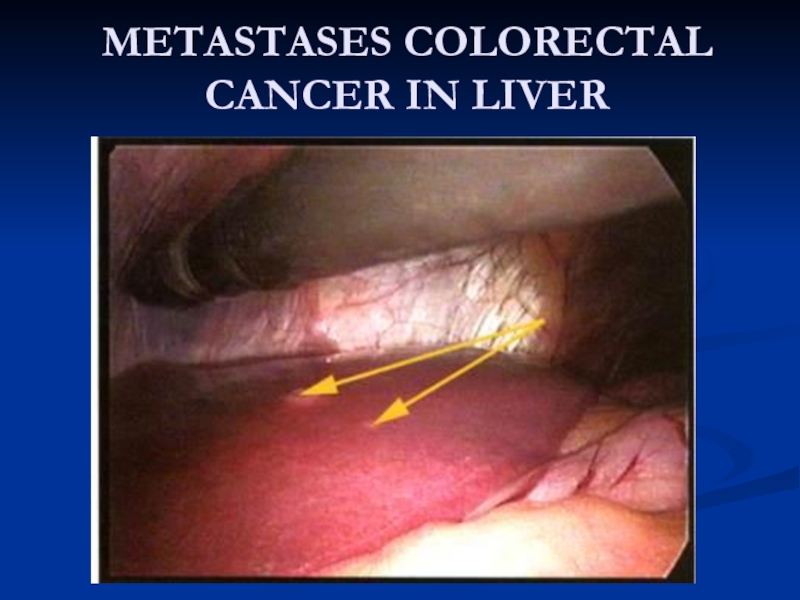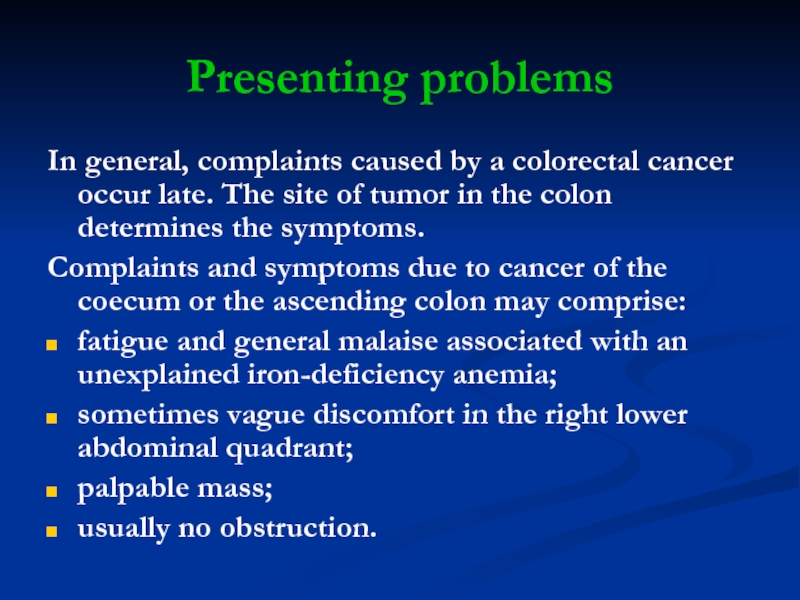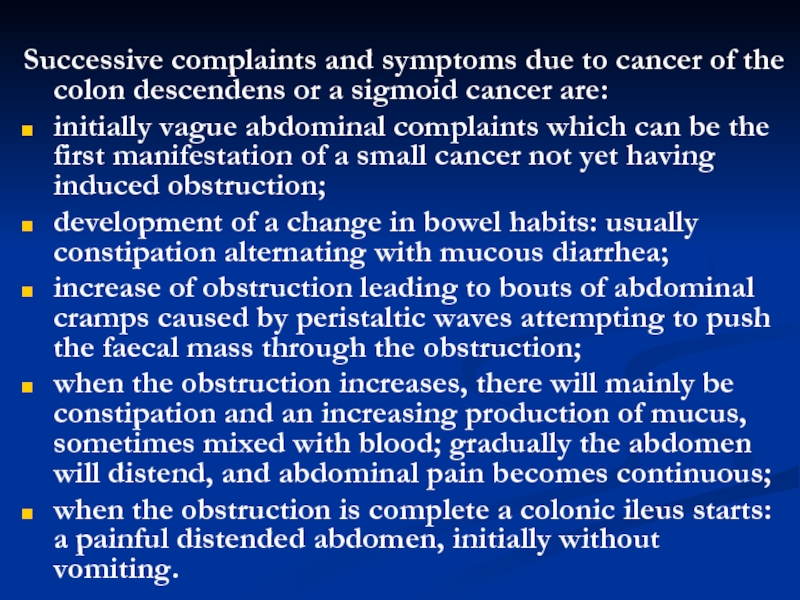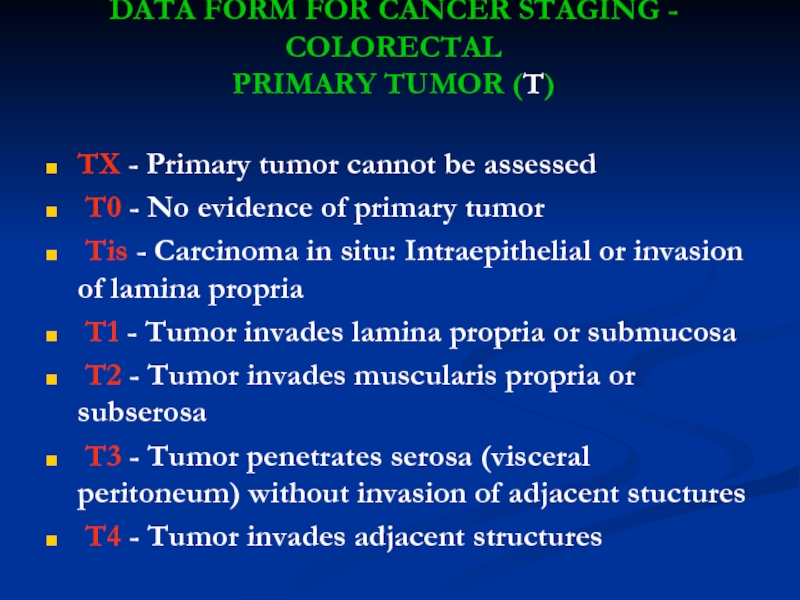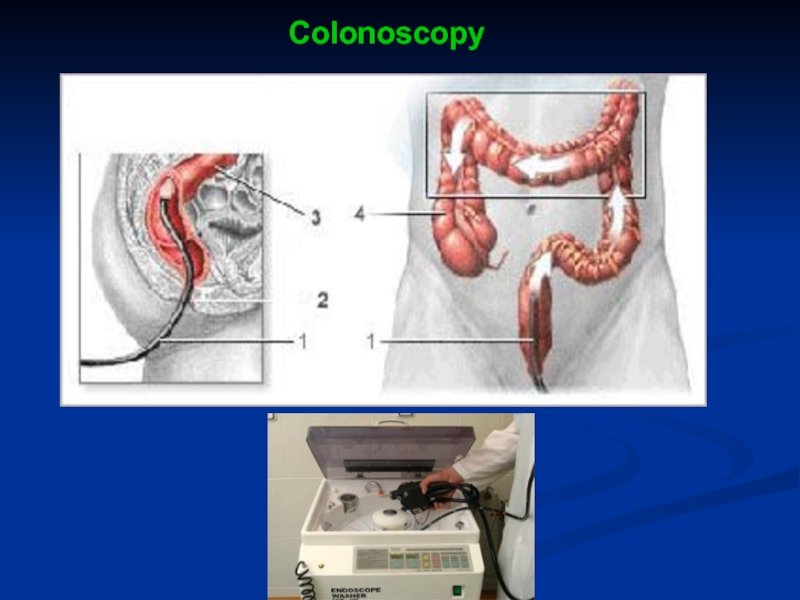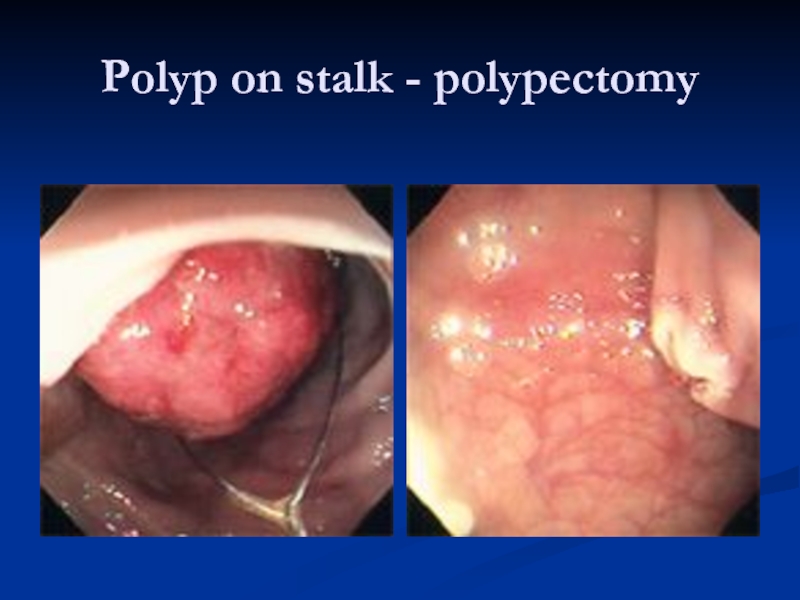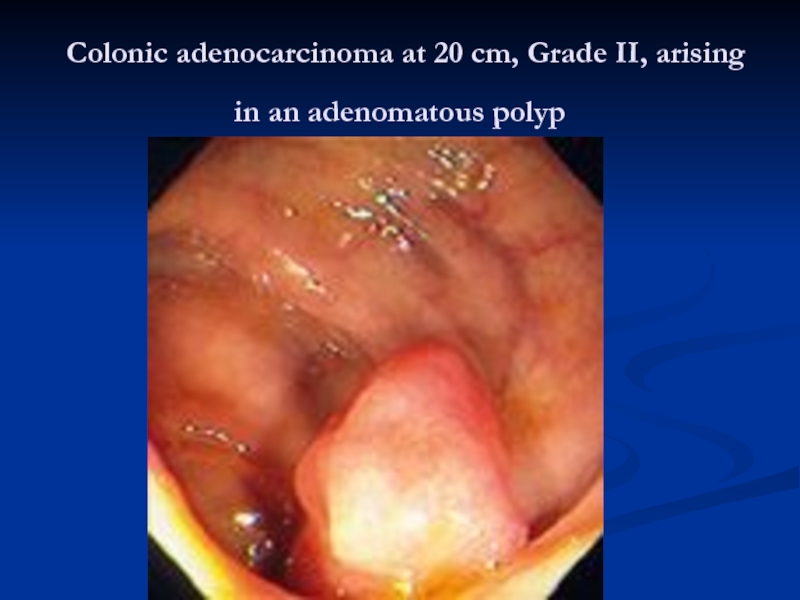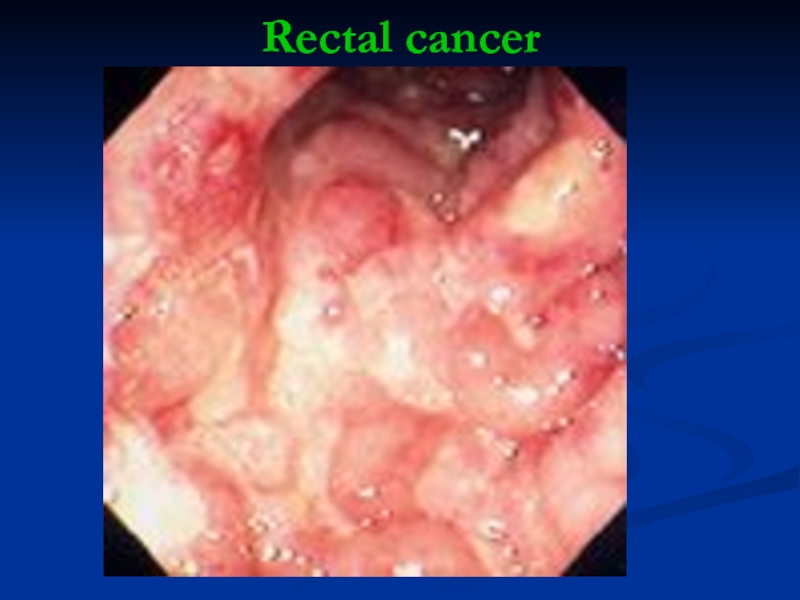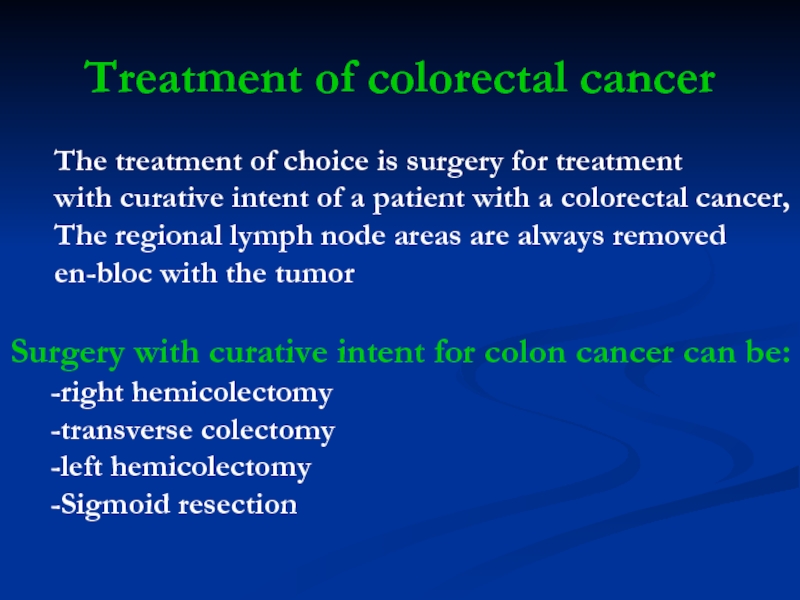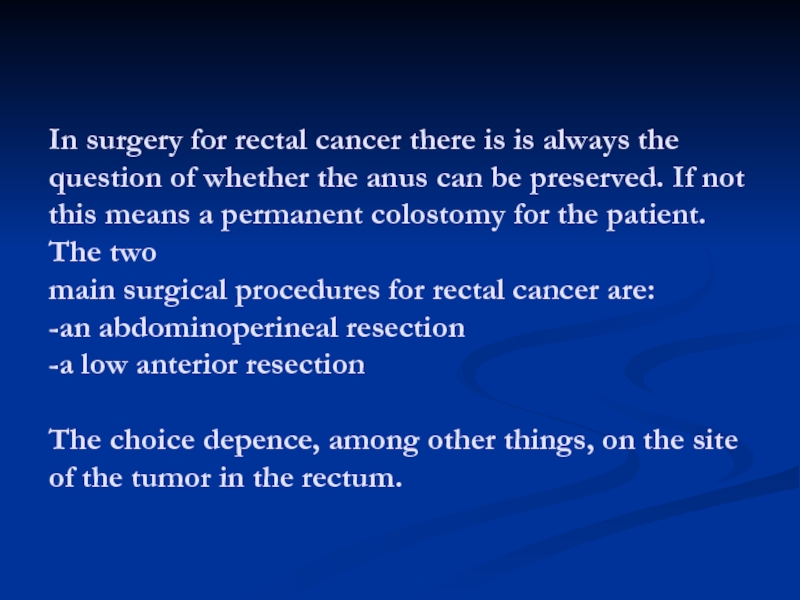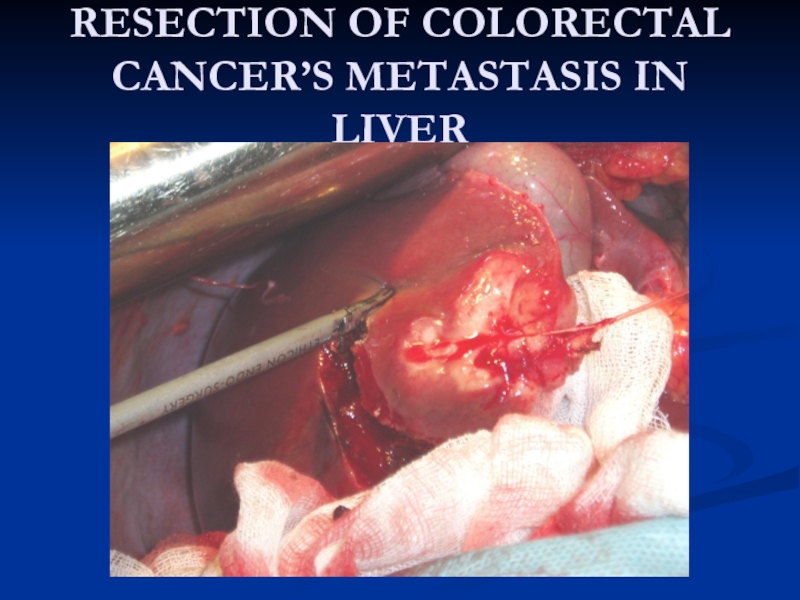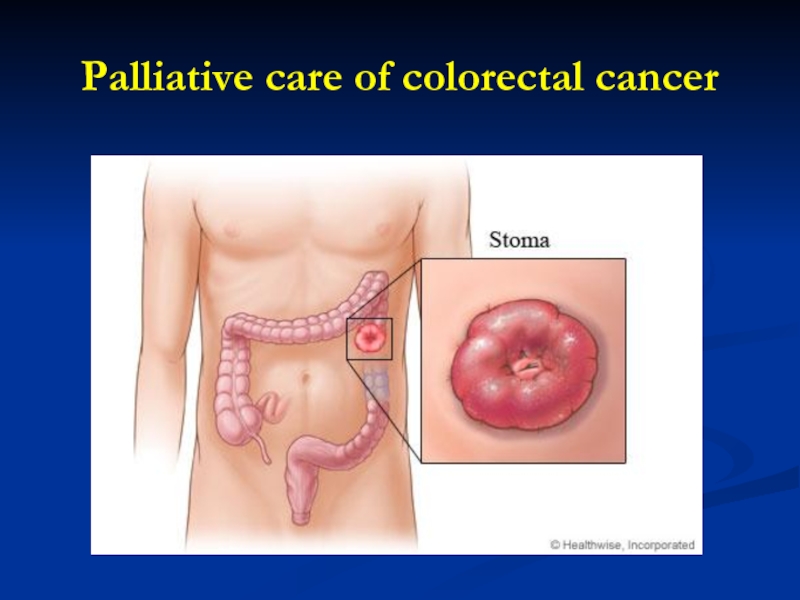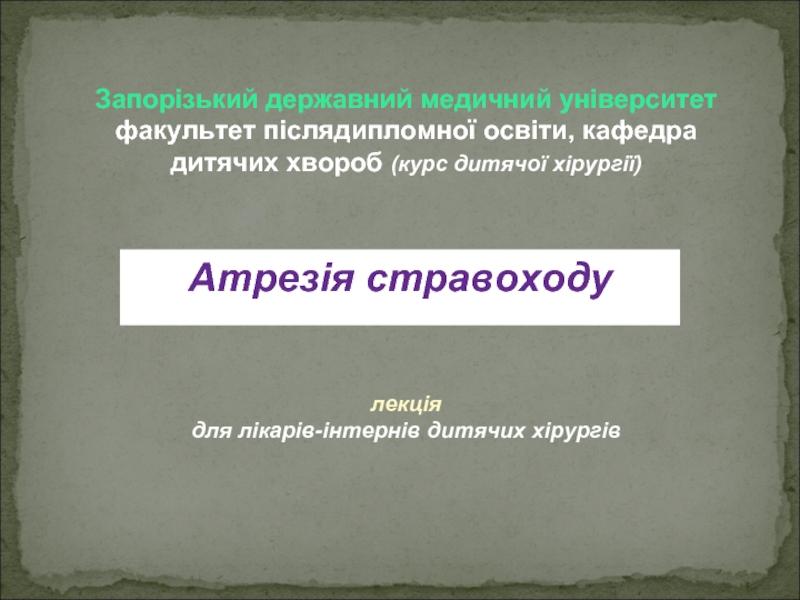- Главная
- Разное
- Дизайн
- Бизнес и предпринимательство
- Аналитика
- Образование
- Развлечения
- Красота и здоровье
- Финансы
- Государство
- Путешествия
- Спорт
- Недвижимость
- Армия
- Графика
- Культурология
- Еда и кулинария
- Лингвистика
- Английский язык
- Астрономия
- Алгебра
- Биология
- География
- Детские презентации
- Информатика
- История
- Литература
- Маркетинг
- Математика
- Медицина
- Менеджмент
- Музыка
- МХК
- Немецкий язык
- ОБЖ
- Обществознание
- Окружающий мир
- Педагогика
- Русский язык
- Технология
- Физика
- Философия
- Химия
- Шаблоны, картинки для презентаций
- Экология
- Экономика
- Юриспруденция
Colorectal cancer презентация
Содержание
- 1. Colorectal cancer
- 2. Epidemiology Colon and rectum cancer accounted for
- 3. In Europe and North-America colorectal cancer
- 4. Epidemiology
- 5. Incidence of colorectal cancer (all countries, 2002)
- 6. RISK FACTORS, COLONIC CARCINOMA Familial adenomatous
- 7. Familial adenomatous polyposis
- 8. Gardner syndrome
- 9. LARGE POLYP IN THE SIGMOID COLON
- 10. Macroscopic local growth Cancers of coecum and
- 11. Macroscopic local growth Cancers of the descending
- 12. Lymphogenic spread
- 13. Haematogenic spread of colorectal cancer
- 14. Metastases of colorectal cancer in lung
- 15. METASTASES COLORECTAL CANCER IN LIVER
- 16. METASTASES COLORECTAL CANCER IN LIVER
- 17. Presenting problems In general, complaints caused by
- 18. Successive complaints and symptoms due to cancer
- 19. When there is suspicion of a sigmoid
- 20. DATA FORM FOR CANCER STAGING -
- 21. STAGE GROUPING
- 22. Colonoscopy
- 23. Polyp on stalk - polypectomy
- 24. Colonic adenocarcinoma at 20 cm,
- 25. Rectal cancer
- 26. Treatment of colorectal cancer The treatment of
- 27. RIGHT HEMICOLECTOMY
- 28. In surgery for rectal cancer there is
- 29. RESECTION OF COLORECTAL CANCER’S METASTASIS IN LIVER
- 30. Palliative care of colorectal cancer
Слайд 2Epidemiology
Colon and rectum cancer accounted for about 1 million new cases
in 2002 (9,4% of the world total), and unlike most sites, numbers were not so different in men and women (ratio, 1,2:1). In terms of incidence, colorectal cancers rank fourth in frecuence in men and third in women.
Слайд 3
In Europe and North-America colorectal cancer is a rather common malignant
disease and it ranks with lung, prostate, and breast cancer as being among the leading malignant solid tumours. The incidence is rather low Japan, Asia, Africa and parts of Latin America.
In the Western countries approximately 50% of the patients with a colorectal cancer die from the disease. That makes colorectal cancer the second greatest cause of cancer death, in men second only to lung cancer, and women second only to breast cancer.
Approximately 85% of the patients with a colorectal cancer are over the age of 50. The incidence increases with age.
In the Western countries approximately 50% of the patients with a colorectal cancer die from the disease. That makes colorectal cancer the second greatest cause of cancer death, in men second only to lung cancer, and women second only to breast cancer.
Approximately 85% of the patients with a colorectal cancer are over the age of 50. The incidence increases with age.
Epidemiology
Слайд 6RISK FACTORS, COLONIC CARCINOMA
Familial adenomatous polyposis syndrome
Hereditary factors
Ulcerative colitis
Crohn's colitis
Schistosomal colitis
Exposure to radiation
Villous polyps
Previous surgery
Ureterocolostomy
Diet rich in fat & meats
High calorie intake
Low dietary calcium intake
Low intake of fermentable fiber
Immunosuppression
Слайд 10Macroscopic local growth
Cancers of coecum and ascending colon are mainly papillomatous
tumors. Because the coecum is wide and the bowel contents are still fluid, definite complaints appear in a late phase. Usually these are preceded for some time (month) by general malaise as a consequence of anemia (due to superficial tumor necrosis and ulceration); or localized vague discomfort in the right lower quadrant.
Слайд 11Macroscopic local growth
Cancers of the descending colon and sigmoid usually grow
circumferential in the intestinal wall, thus leading to stenosis. Sooner or later this will induce complaints of obstruction, especially because the content in the left part of the colon is more solid.
Слайд 17Presenting problems
In general, complaints caused by a colorectal cancer occur late.
The site of tumor in the colon determines the symptoms.
Complaints and symptoms due to cancer of the coecum or the ascending colon may comprise:
fatigue and general malaise associated with an unexplained iron-deficiency anemia;
sometimes vague discomfort in the right lower abdominal quadrant;
palpable mass;
usually no obstruction.
Complaints and symptoms due to cancer of the coecum or the ascending colon may comprise:
fatigue and general malaise associated with an unexplained iron-deficiency anemia;
sometimes vague discomfort in the right lower abdominal quadrant;
palpable mass;
usually no obstruction.
Слайд 18Successive complaints and symptoms due to cancer of the colon descendens
or a sigmoid cancer are:
initially vague abdominal complaints which can be the first manifestation of a small cancer not yet having induced obstruction;
development of a change in bowel habits: usually constipation alternating with mucous diarrhea;
increase of obstruction leading to bouts of abdominal cramps caused by peristaltic waves attempting to push the faecal mass through the obstruction;
when the obstruction increases, there will mainly be constipation and an increasing production of mucus, sometimes mixed with blood; gradually the abdomen will distend, and abdominal pain becomes continuous;
when the obstruction is complete a colonic ileus starts: a painful distended abdomen, initially without vomiting.
initially vague abdominal complaints which can be the first manifestation of a small cancer not yet having induced obstruction;
development of a change in bowel habits: usually constipation alternating with mucous diarrhea;
increase of obstruction leading to bouts of abdominal cramps caused by peristaltic waves attempting to push the faecal mass through the obstruction;
when the obstruction increases, there will mainly be constipation and an increasing production of mucus, sometimes mixed with blood; gradually the abdomen will distend, and abdominal pain becomes continuous;
when the obstruction is complete a colonic ileus starts: a painful distended abdomen, initially without vomiting.
Слайд 19When there is suspicion of a sigmoid cancer it is important
to ask if there has been:
A slow change in bowel habits
Decrease of stool calibre (‘pencil stools’), possibly with mucus and/or blood.
When there is any suspicion for a rectal cancer it is important to ask if there has been:
blood on the stools
False defecation urge
Sometimes a feeling that after defecation the rectum is not yet empty.
The latter two symptoms are due to the fact that the intestinal wall cannot differentiate between the tumor and the stools and consequently keeps on constricting to push the “content” downward.
Rectal loss of blood is an important sign that may indicate the presence of a recto/sigmoid cancer. Most treacherous is the co-existence of hemorrhoids! The existence of one of more hemorrhoids, especially also when bleeding, does not exclude the existence of a rectosigmoid cancer! On the contrary, straining due to an obstruction caused by rectosigmoid cancer, can be the cause of the development of hemorrhoids.
A slow change in bowel habits
Decrease of stool calibre (‘pencil stools’), possibly with mucus and/or blood.
When there is any suspicion for a rectal cancer it is important to ask if there has been:
blood on the stools
False defecation urge
Sometimes a feeling that after defecation the rectum is not yet empty.
The latter two symptoms are due to the fact that the intestinal wall cannot differentiate between the tumor and the stools and consequently keeps on constricting to push the “content” downward.
Rectal loss of blood is an important sign that may indicate the presence of a recto/sigmoid cancer. Most treacherous is the co-existence of hemorrhoids! The existence of one of more hemorrhoids, especially also when bleeding, does not exclude the existence of a rectosigmoid cancer! On the contrary, straining due to an obstruction caused by rectosigmoid cancer, can be the cause of the development of hemorrhoids.
Слайд 20
DATA FORM FOR CANCER STAGING - COLORECTAL
PRIMARY TUMOR (T)
TX -
Primary tumor cannot be assessed
T0 - No evidence of primary tumor
Tis - Carcinoma in situ: Intraepithelial or invasion of lamina propria
T1 - Tumor invades lamina propria or submucosa
T2 - Tumor invades muscularis propria or subserosa
T3 - Tumor penetrates serosa (visceral peritoneum) without invasion of adjacent stuctures
T4 - Tumor invades adjacent structures
T0 - No evidence of primary tumor
Tis - Carcinoma in situ: Intraepithelial or invasion of lamina propria
T1 - Tumor invades lamina propria or submucosa
T2 - Tumor invades muscularis propria or subserosa
T3 - Tumor penetrates serosa (visceral peritoneum) without invasion of adjacent stuctures
T4 - Tumor invades adjacent structures
Слайд 26Treatment of colorectal cancer
The treatment of choice is surgery for treatment
with curative intent of a patient with a colorectal cancer,
The regional lymph node areas are always removed
en-bloc with the tumor
Surgery with curative intent for colon cancer can be:
-right hemicolectomy
-transverse colectomy
-left hemicolectomy
-Sigmoid resection
Слайд 28In surgery for rectal cancer there is is always the question
of whether the anus can be preserved. If not
this means a permanent colostomy for the patient. The two
main surgical procedures for rectal cancer are:
-an abdominoperineal resection
-a low anterior resection
The choice depence, among other things, on the site of the tumor in the rectum.
